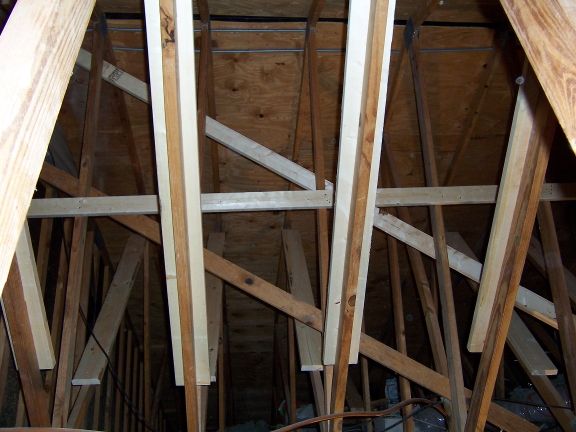Repairs to Roof Trusses
Safety Concerns and Cosmetic Damage
Despite all new houses requiring an inspection, serious construction errors like these shown below, often pass unnoticed. This house was built in the early 1980's. Although the roof never fell down, this lack of proper (and actually always required!) truss bracing resulted in ugly and expensive damage to the ceiling in the kitchen area. Proper installation during construction would have cost less than $100, materials and labor.
Although the drywall repairs were quite expensive for this job, the repairs to properly brace the roof were very inexpensive! Installing these braces after construction is more difficult, but is still a good return on only a small amount of money.
Ignoring the cosmetic issues that may be possible, there are very serious safety concerns when roofs are improperly braced. If your home is lacking proper bracing, you should repair this. Homes can stand, apparently strong, for many years. One particular storm, blowing in the right direction, could suddenly do unexpected and expensive damage.
This photo shows all three needed repairs.
- T-bracing. This is placed on the backs of long truss members to prevent bowing.
- Cross-bracing. This is usually used crossing and connecting long vertical truss members to prevent bowing.
- Gable bracing. This is only used on homes with gables. It prevents the whole roof moving at the top, back and forth in high winds.

In all of these photos, dark wood is original, white wood is new work.
T-bracing is the 2x6 shown on only one truss.
Cross-bracing is the level, not diagonal, 2x4 that crosses all trusses.
Gable bracing is the diagonal bracing that runs across many trusses. Note this carefully, please.

Gable bracing is the diagonal bracing that runs across many trusses.
This photo clearly shows one error that used to be permitted in the past.
This error would have passed inspection when this house was built.
Note that the old, dark diagonal bracing did not end on top of a wall, but instead ends connected to a truss!
When the wind blows hard, the ceiling here bounces up and down, eventually damaging the drywall ceiling.
New code requires this brace to end on top of a wall which can carry the load down to the ground, not to the ceiling.



Last Updated: July 29, 2009
